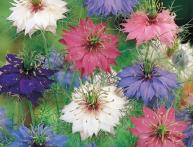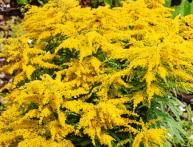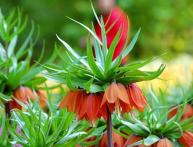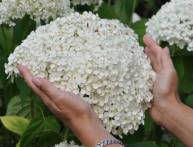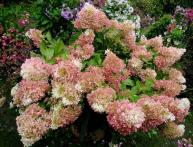Buzulnik serrated: features of planting and caring for the plant
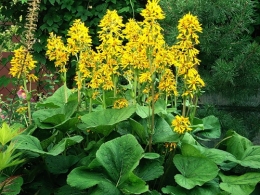
Many gardeners value buzulnik for its beautiful flowering and appearance of the bush. This ornamental plant has yellow or orange flowers. Translated from Latin buzulnik means "tongue". The plant does not require special care.
Content:
Description of the plant
Buzulnik is a perennial herbaceous plant belonging to the Asteraceae family. It can reach more than a meter in height. Its stems are straight. Large heart-shaped leaves grow on them, collected in a rosette. Depending on the variety, their shade can be green, greenish-violet or red-brown.
The inflorescences of the buzulnik are in the form of a basket, which is about 7-8 cm in diameter. The flowers are tubular in a bright yellow, orange and reddish hue. Flowering usually begins at the end of summer and lasts for 30 days. The plant has a fruit - a tufted achene. There are several varieties of jagged buzulnik:
- Variety Desdemona. This variety can grow up to 1 meter in height. The leaves of this variety of buzulnik are lilac-brown in color, and the flowers are fiery orange.
- Othello variety. The leaves are purple with a diameter of up to 50 cm. The inflorescences are bright orange and are 13 cm in diameter.
- Variety Brit Marie Crawford. It differs from other types of varieties in its rich red leaves. The inflorescences are yellow and bright.
- Variety Osiris Fantasy. Belongs to dwarf varieties.The plant does not exceed 50 cm in length. The outer part of the leaves is dark green and the inner part is burgundy.
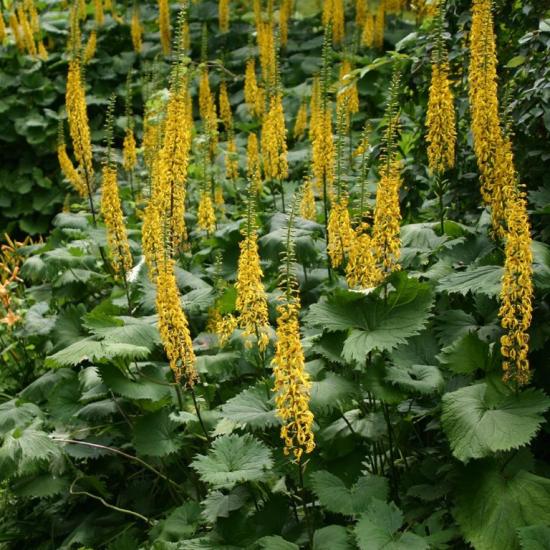
Buzulnik looks great alone or with other flowers.
Reproduction methods
This plant is propagated in one of two ways:
- Seeds
- Dividing the bush
Sowing seeds directly into the soil should be done in the spring. The depth of the seed is no more than 1 cm. The soil must be well moistened until seedlings appear. You can sow seeds in the fall. After winter they will undergo stratification and the first seedlings will appear in the spring.
Sowing of seedlings must be carried out in January-March, and planting in the ground is carried out after spring frosts. The perennial will begin to bloom only 3-4 years after landings. Propagating the plant in this way is quite difficult due to the collection and preparation of seed material. Seeds are collected in the fall. At the end of flowering, several inflorescences should be tied with gauze.
After they dry, you need to cut them and bring them indoors. Shake it out and remove any remaining flowers. If necessary, the seeds need to be dried and poured into a bag or box.
The plant should be replanted and divided every five years, although buzulnik can grow in the same place for about 20 years. Replanting should be done in the spring during the period of active growth and the appearance of young leaves.
There is no need to dig up the plant completely. Use a shovel to cut off part of the bush, which we subsequently dig up. After dividing, cover the mother plant with soil and water it. Wash the division in water and then divide it so that one bud remains on each bush. The cut areas must be treated with a solution of potassium permanganate or crushed coal.
Next, you need to prepare a place for planting.It is not advisable to choose sunny places for planting, since in such areas the buzulnik will constantly lack moisture. As a result, the plant will lose its attractive appearance. It is recommended to plant it near water bodies.
Planting a division is carried out as follows: dig several holes measuring 40x40 cm. They should be located 1-1.5 meters apart from each other. Next enter feeding: humus, ash and superphosphate in a ratio of 2:1:1. This method of propagating buzulnik is the simplest and even a novice gardener can handle it.
Rules for caring for buzulnik
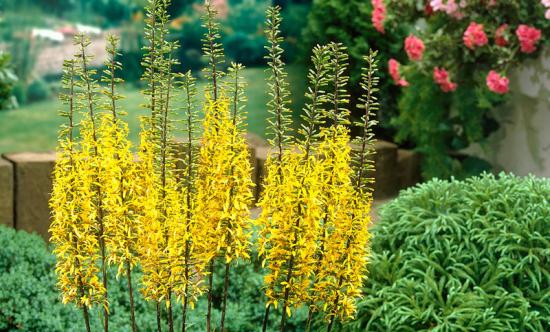
Buzulnik has powerful leaves and many inflorescences that need to be watered regularly. Pruning of a perennial plant should be done at the end of the season, removing flower stalks. To make it easier for the plant to overwinter, you should remove the entire part of the bush that is above the ground. This procedure is performed before the onset of frost.
Buzulnik is very fond of feeding and fertilizers. The first fertilizing should be applied when planting. For this purpose, humus is used. Next, before flowering begins, fertilizer is applied to each bush of the plant: liquid mullein diluted in 10 liters of water. The plant should be watered with this fertilizer once every 2 weeks, 3 liters per bush. It's important to remember that fertilizer Apply only under the bush. Avoid contact with roots.
Caring for buzulnik includes mulching. This procedure must be performed in mid-autumn using humus. Wood ash can be added periodically in small quantities. Buzulnik is resistant to many pests and diseases. Most often the leaves of the plant are affected by slugs.To get rid of them, you should sprinkle a few granules of superphosphate under the plant.
In case of development of a fungal disease - powdery mildew, it is recommended to disinfect the leaves with a solution of potassium permanganate. Buzulnik is unpretentious in care, so even a novice gardener will not experience any particular difficulties.
Toothed buzulnik on video:



